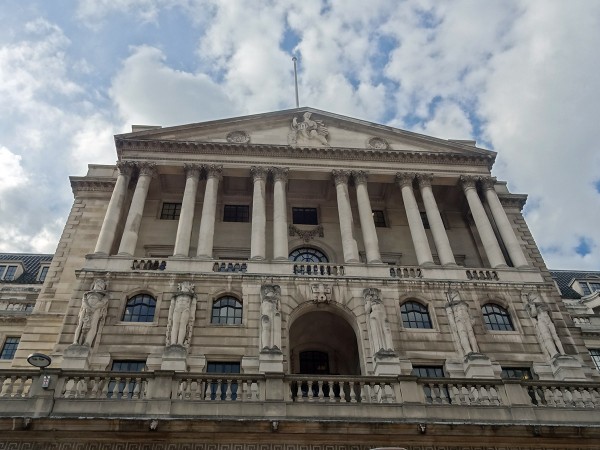 Interest rates in the UK have been at 0.5% since mid-2009, when they were reduced with the objective of stimulating the economy, through encouraging consumption and investment. Over the past 12 months, economic recovery has begun and with the housing market rising by 8.4% over the past year, what can we expect from interest rates?
Interest rates in the UK have been at 0.5% since mid-2009, when they were reduced with the objective of stimulating the economy, through encouraging consumption and investment. Over the past 12 months, economic recovery has begun and with the housing market rising by 8.4% over the past year, what can we expect from interest rates?
Interest rates are a powerful tool of monetary policy and affect many of the components of aggregate demand. As such, they are also a key tool in achieving low and stable inflation rates and keeping unemployment low. Unemployment has been falling, as the economic recovery has taken hold, but is still above the 7% level that the Bank of England has said is needed before rates are increased. However, with the improvements in the housing market, some are now expecting interest rates to go up sooner than previously thought. (Click here for a PowerPoint of the chart.)
some are now expecting interest rates to go up sooner than previously thought. (Click here for a PowerPoint of the chart.)
28 economists were questioned about the future of interest rates in the UK and 93% of those asked were of the opinion that interest rates will still be at 0.5% by the end of 2014. Furthermore, more than 50% think that interest rates will not begin to go up until the second half of 2015 and 15% suggest that they will not increase until 2016.
What happens to interest rates will depend on many things, including changes in productivity, unemployment trends, wage growth and inflation. It is also likely to depend on economic changes in countries around the world. The following articles consider the future of interest rates.
UK interest rates to stay at 0.5% in 2014 – economists BBC News (3/1/14)
It is high time we raised interest rates and returned to normality The Telegraph, Jeremy Warner (2/1/14)
BoE will ‘move goalposts’ on interest rates Financial Times, Chris Giles and Claire Jones (1/1/14)
Interest rate rise with no wage increase ‘will push heavily-indebted to edge’ The Guardian, Heather Stewart (2/12/14)
BoE may lower jobless rate guidance, but not this month – Reuters poll Reuters, Suzanne Plunkett (3/1/14)
Questions
- Explain how each component of aggregate demand will be affected by changes in interest rates.
- How do interest rates affect unemployment?
- Interest rates are used to keep inflation on target. Explain how this is done.
- What might be the effect on the macroeconomic objectives if interest rates are increased?
- What are the arguments (a) for increasing Bank rate and (b) for maintaining it at the current 0.5% level?
 As the old year gives way to the new, papers have been full of economic forecasts for the coming year. This year is no exception. The authors of the articles below give their predictions of what is to come for the global economy and, for the most part, their forecasts are relatively optimistic – but not entirely so. Despite a sunny outlook, there are various dark clouds on the horizon.
As the old year gives way to the new, papers have been full of economic forecasts for the coming year. This year is no exception. The authors of the articles below give their predictions of what is to come for the global economy and, for the most part, their forecasts are relatively optimistic – but not entirely so. Despite a sunny outlook, there are various dark clouds on the horizon.
Most forecasters predict a higher rate of global economic growth in 2014 than in 2013 – and higher still in 2015. The IMF, in its October forecasts, predicted global growth of 3.6% in 2014 (up from 2.9% in 2013) and 4.0% in 2015.
Some countries will do much better than others, however. The USA, the UK, Germany and certain developing countries are forecast to grow more strongly. The eurozone as a whole, however, is likely to see little in the way of growth, as countries such as Greece, Spain, Portugal and Italy continue with austerity policies in an attempt to reduce their debt. 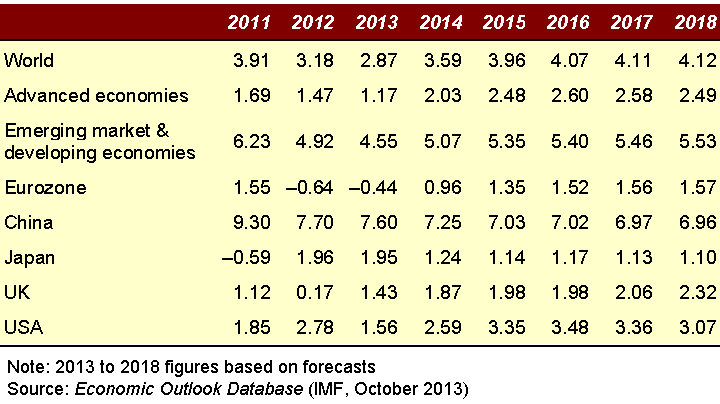 Chinese growth has slowed, as the government seeks to rebalance the economy away from exports and investment in manufacturing towards consumption, and services in particular. It is still forecast to be 7.3% in 2014, however – well above the global average. Japanese growth has picked up in response to the three arrows of fiscal, monetary and supply-side policy. But this could well fade somewhat as the stimulus slows. The table shows IMF growth forecasts for selected countries and groups of countries to 2018.
Chinese growth has slowed, as the government seeks to rebalance the economy away from exports and investment in manufacturing towards consumption, and services in particular. It is still forecast to be 7.3% in 2014, however – well above the global average. Japanese growth has picked up in response to the three arrows of fiscal, monetary and supply-side policy. But this could well fade somewhat as the stimulus slows. The table shows IMF growth forecasts for selected countries and groups of countries to 2018.
Much will depend on what happens to monetary policy around the world. How quickly will monetary stimulus taper in the USA and in Japan? Will the ECB introduce more aggressively expansionary monetary policy? When will the Bank of England start raising interest rates?
Growth within countries is generally favouring those on higher incomes, with the gap between rich and poor set to continue widening over the coming years. The pay of top earners has continued to rise considerably faster than prices, while increasingly flexible labour markets and squeezed welfare budgets have seen a fall in living standards of many on low incomes. According to a Which? survey (reported in the Independent article below), in the UK:
Only three in ten expect their family’s situation to improve in the new year, while 60% said they are already dreading the arrival of their winter energy bill. The Which? survey also found that 13 million people could afford to pay for Christmas only by borrowing, with more than four in ten using credit cards, loans or overdrafts to fund their festive spending. A third of people (34%) also dipped into their savings, taking an average of £450 from their accounts.
If recovery is based on borrowing, with real incomes falling, or rising only very slowly, household debt levels are likely to increase. This has been stoked in the UK by the ‘Help to Buy‘ scheme, which has encouraged people to take on more debt and has fuelled the current house price boom. This could prove damaging in the long term, as any decline in confidence could lead to a fall in consumer expenditure once more as people seek to reduce their debts.
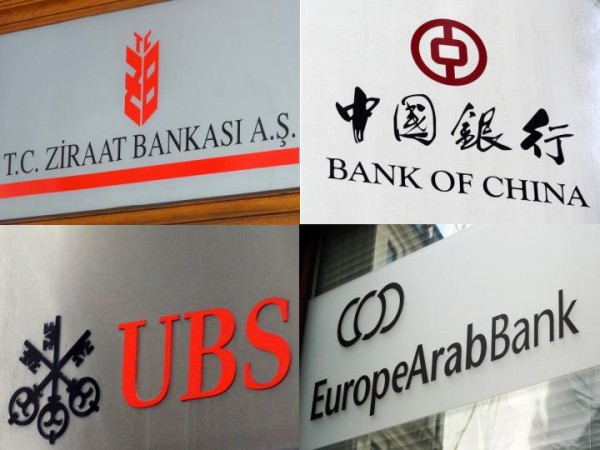 And what of the global banking system? Is it now sufficiently robust to weather a new crisis. Is borrowing growing too rapidly? Is bank lending becoming more reckless again? Are banks still too big to fail? Is China’s banking system sufficiently robust? These are questions considered in the articles below and, in particular, in the New York Times article by Gordon Brown, the former Prime Minister and Chancellor of the Exchequer.
And what of the global banking system? Is it now sufficiently robust to weather a new crisis. Is borrowing growing too rapidly? Is bank lending becoming more reckless again? Are banks still too big to fail? Is China’s banking system sufficiently robust? These are questions considered in the articles below and, in particular, in the New York Times article by Gordon Brown, the former Prime Minister and Chancellor of the Exchequer.
Articles
Global economy: hopes and fears for 2014The Observer, Heather Stewart and Larry Elliott (29/12/13)
Looking ahead to 2014 BBC News, Linda Yueh (20/12/13)
Low hopes for a happy new financial year in 2014 Independent, Paul Gallagher (29/12/13)
Brisk UK economic growth seen in 2014 fuelled by spending – Reuters poll Reuters, Andy Bruce (12/12/13)
GLobal Economy: 2014 promises faster growth, but no leap forward Reuters, Andy Bruce (29/12/13)
My 2014 Economic Briefing Huffington Post, Tony Dolphin (27/12/13)
Three UK Economy Stories that will Dominate in 2014 International Business Times, Shane Croucher (27/12/13)
Who You Calling a BRIC? Bloomberg, Jim O’Neill (12/11/13)
Hope and Hurdles in 2014 Project Syndicate, Pingfan Hong (27/12/13)
On top of the world again The Economist (18/11/13)
Digging deeper The Economist (31/10/13)
BCC Economic Forecast: growth is gathering momentum, but recovery is not secure British Chambers of Commerce (12/13)
Eight predictions for 2014 Market Watch, David Marsh (30/12/13)
Stumbling Toward the Next Crash New York Times, Gordon Brown (18/12/13)
Central banks must show leadership to rejuvenate global economy The Guardian, Larry Elliott (1/1/14)
Global economy set to grow faster in 2014, with less risk of sudden shocks The Guardian, Nouriel Roubini (31/12/13)
A dismal new year for the global economy The Guardian, Joseph Stiglitz (8/1/14)
Forecasts and reports
World Economic Outlook (WEO) IMF (October 2013)
Economic Outlook OECD (November 2013)
Output, prices and jobs The Economist
Bank of England Inflation Report: Overview Bank of England (November 2013)
Questions
- What reasons are there to be cheerful about the global economic prospects for 2014 and 2015?
- Who will gain the most from economic growth in the UK and why?
- Why is the eurozone likely to grow so slowly, if at all?
- Are we stumbling towards another banking crisis, and if so, which can be done about it?
- Why has unemployment fallen in the UK despite falling living standards for most people?
- What is meant by ‘hysteresis’ in the context of unemployment? Is there a problem of hysteresis at the current time and, if so, what can be done about it?
- Explain whether the MINT economies are likely to be a major source of global economic growth in the coming year?
- Why is it so difficult to forecast the rate of economic growth over the next 12 months, let alone over a longer time period?
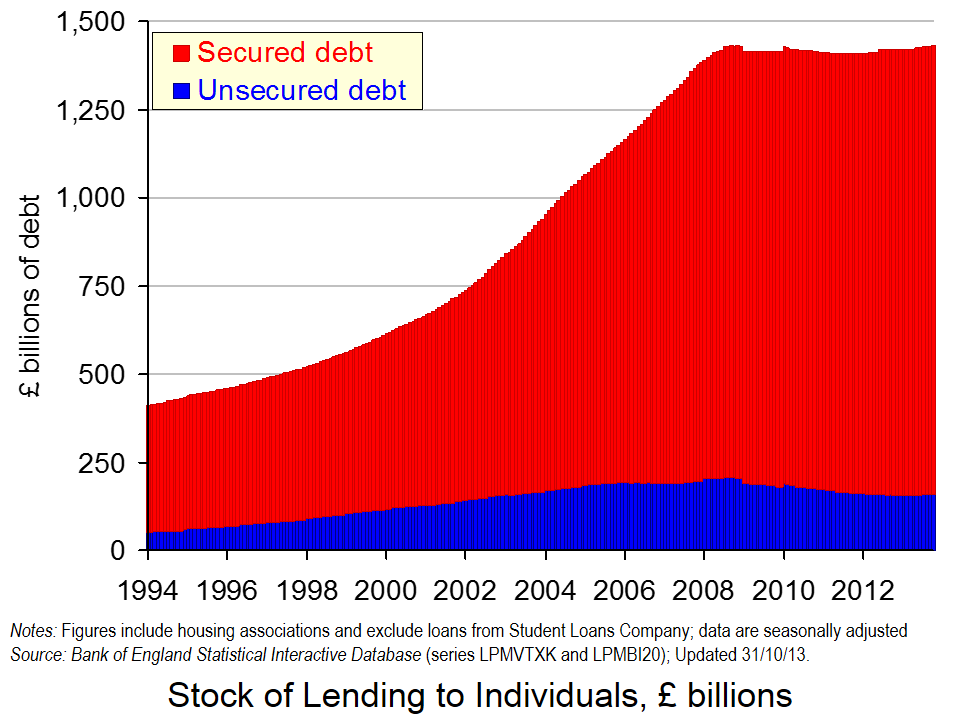 As of 31 October 2013, British households had a stock of debt close to £1.43 trillion. Economists are increasingly recognising that the financial well-being of economic agents is an important macroeconomic issue. The financial position of households, businesses and governments can be expected to affect behaviour and, hence, economic activity.
As of 31 October 2013, British households had a stock of debt close to £1.43 trillion. Economists are increasingly recognising that the financial well-being of economic agents is an important macroeconomic issue. The financial position of households, businesses and governments can be expected to affect behaviour and, hence, economic activity.
We can calculate the net financial wealth of households as the difference between their stock of financial assets (savings) and their financial liabilities (debt). The latest figures from the Bank of England’s Money and Credit show that as of Halloween 2013, British households had amassed a stock of debt of £1.4296 trillion. It is certainly a large figure since it not far short of the expected GDP figure for 2013 of around £1.6 trillion.
The chart above helps to show that of the aggregate household debt, £1.271 trillion is secured debt (debt secured against property). The remaining stock of £158.589 billion is unsecured debt (e.g. overdrafts, outstanding credit card debt and personal loans). In short, 89 per cent of the stock of outstanding household debt is mortgage debt. (Click here to download a PowerPoint of the chart.)
In January 1994 the stock of secured debt stood at £358.75 billion and the stock of unsecured debt at £53.773 billion. 87 per cent of debt then was secured debt and, hence, little different to today. The total stock of debt has grown by 247 per cent between January 1994 and October 2013. Unsecured debt has grown by 199 per cent while secured debt has grown by 254 per cent.
But, consider now the path of debt between the end of October 2008 and October 2013. During this period, the monthly series of the stock of unsecured debt has fallen on 52 occasions and risen on only 9 occasions. In contrast, the stock of secured debt has fallen on only 10 occasions and often by very small amounts. Consequently, the stock of unsecured debt has fallen by 22.8 per cent between the end of October 2008 and October 2013. In contrast, the stock of secured debt has risen by 3.9 per cent. The total stock of debt has risen by 0.1 per cent over this period and, therefore, it is essentially unchanged.
The amount of debt accumulated by households is example of the increasing importance of the financial system in our everyday lives. The term financialisation helps to capture this. Financialisation means that economists need to think much more about how financial institutions and the financial well-being of people, businesses and governments affect economic activity. There is little doubt that the financial position or financial health of economic agents, such as households, affects their behaviour. We would expect in the case of households for their financial well-being to exert an influence on their propensities to spending or save. But, just how is an area in need of much, much more research.
Articles
UK household debt hits record high BBC News (29/11/13)
Average household debt ‘doubled in last decade’ Telegraph, Edward Malnick (20/11/13)
£1,430,000,000,000 (that’s £1.43 trillion): Britain’s personal debt timebomb Independent, Andrew Grice (20/11/13)
Data
Money and Credit – October 2013 Bank of England
Statistical Interactive Database Bank of England
Questions
- Outline the ways in which the financial system could impact on the spending behaviour of households.
- Why might the current level of income not always be the main determinant of a household’s spending?
- How might uncertainty affect spending and saving by households?
- Explain what you understand by net lending to individuals. How does net lending to individuals affect stocks of debt?
- Outline the main patterns seen in the stock of household debt over the past decade and discuss what you consider to be the principal reasons for these patterns.
- What factors might explain the rather different pattern seen in the growth of debt since October 2008 compared with that in earlier part of the 2000s?
- What do you understand by the term financialisation? Of what importance is this phenomenon to economic behaviour?
 A constant feature of the UK economy (and of many other Western economies) has been record low interest rates. Since March 2009, Bank Rate has stood at 0.5%. Interest rates have traditionally been used to keep inflation on target, but more recently their objective has been to stimulate growth. However, have these low interest rates had a negative effect on the business environment?
A constant feature of the UK economy (and of many other Western economies) has been record low interest rates. Since March 2009, Bank Rate has stood at 0.5%. Interest rates have traditionally been used to keep inflation on target, but more recently their objective has been to stimulate growth. However, have these low interest rates had a negative effect on the business environment?
Interest rates are a powerful tool of monetary policy and by affecting many of the components of aggregate demand, economic growth can be stimulated. This low-interest rate environment is an effective tool to stimulate consumer spending, as it keeps borrowing costs low and in particular can keep mortgage repayments down. However, this policy has been criticised for the harm it has been doing to savers – after all, money in the bank will not earn an individual any money with interest rates at 0.5%! Furthermore, there is now a concern that such low interest rates have led to ‘zombie companies’ and they are restricting the growth potential and recovery of the economy.
A report by the Adam Smith Institute suggests that these ‘zombie companies’ have emerged in part by the low-interest environment and are continuing to absorb resources, which could otherwise be re-allocated to companies with more potential, productivity and a greater contribution to the economic recovery. During a recession, there will undoubtedly be many business closures, as aggregate demand falls, sales and profits decline until eventually the business becomes unviable and loans cannot be repaid. Given the depth and duration of the recent recessionary period, the number of business closures should have been very large. However, the total number appears to be relatively low – around 2% or 100,000 and the report suggests that the low interest rates have helped to ‘protect’ them.
Low interest rates have enabled businesses to meet their debt repayments more easily and with some banks being unwilling to admit to ‘bad loans’, businesses have benefited from loans being extended or ‘rolled over’. This has enabled them to survive for longer and as the report suggests, may be preventing a full recovery. The report’s author, Tom Papworth said:
Low interest rates and bank forbearance represent a vast and badly targeted attempt to avoid dealing with the recession. Rather than solving our current crisis, they risk dooming the UK to a decade of stagnation … We tend to see zombies as slow-moving and faintly laughable works of fiction. Economically, zombies are quite real and hugely damaging, and governments and entrepreneurs cannot simply walk away.
The problem they create is that resources are invested into these companies – labour, capital, innovation. This creates an opportunity cost – the resources may be more productive if invested into new companies, with greater productive potential. The criticism is that the competitiveness of the economy is being undermined by the continued presence of such companies and that this in turn is holding the UK economy back. Perhaps the interest rate rise that may happen this time next year may be what is needed to encourage the re-allocation of capital. However, a 0.5 percentage point rise in interest rates would hardly be the end of the world for some of these companies. Perhaps a more focused approach looking at restructuring is the key to their survival and the allocation of resources to their most productive use. The following articles and the report itself consider the case of the trading dead.
Report
The Trading Dead The Adam Smith Institute, Tom Papworth November 2013
Articles
Zombie firms threaten UK’s economic recovery, says thinktank The Guardian, Gyyn Topam (18/11/13)
 Zombie companies ‘probably have no long term future’ BBC News (18/11/13)
Zombie companies ‘probably have no long term future’ BBC News (18/11/13)
Rate rise set to put stake through heart of zombie companies Financial Times, Brian Groom (14/11/13)
Why we can still save the zombie firms hindering the UK economic rival City A.M., Henry Jackson (18/11/13)
Breathing new life into zombies The Telegraph, Rachel Bridge (9/11/13)
Questions
- Which components of aggregate demand are affected (and how) by low interest rates?
- Why do low interest rates offer ‘protection’ to vulnerable businesses?
- How is the reallocation of resources relevant in the case of zombie companies?
- If interest rates were to increase, how would this affect the debts of vulnerable businesses? Would a small rate irse be sufficient and effective?
- What suggestions does the report give for zombie companies to survive and become more productive?
- Is there evidence of zombie companies in other parts of the world?
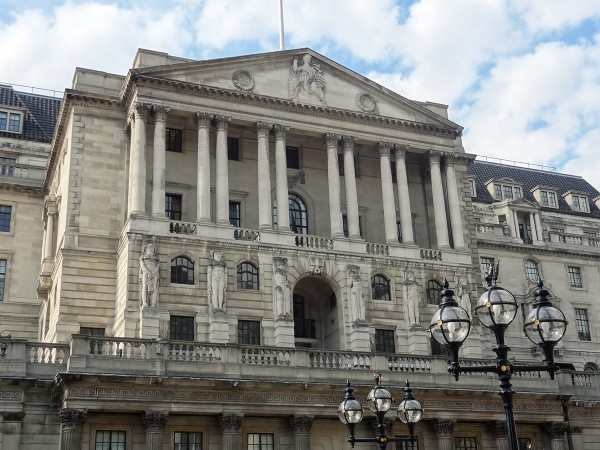 The Consumer Prices index (CPI) measures the rate of inflation and in October, this rate fell to 2.2%, bringing inflation to its lowest level since September 2012. For many, this drop in inflation came as a surprise, but it brings the rate much closer to the Bank of England’s target and thus reduces the pressure on changing interest rates.
The Consumer Prices index (CPI) measures the rate of inflation and in October, this rate fell to 2.2%, bringing inflation to its lowest level since September 2012. For many, this drop in inflation came as a surprise, but it brings the rate much closer to the Bank of England’s target and thus reduces the pressure on changing interest rates.
The CPI is calculated by calculating the weighted average price of a basket of goods and comparing how this price level changes from one month to the next. Between September and October prices across a range of markets fell, thus bringing inflation to its lowest level in many months. Transport prices fell by their largest amount since mid-2009, in part driven by fuel price cuts at the big supermarkets and this was also accompanied by falls in education costs and food. The Mail Online article linked below gives a breakdown of the sectors where the largest price falls have taken place. One thing that has not yet been included in the data is the impact of the price rises by the energy companies. The impact of his will obviously be to raise energy costs and hence we can expect to see an impact on the CPI in the coming months, once the price rises take effect.
 With inflation coming back on target, pressures on the Bank of England to raise interest rates have been reduced. When inflation was above the target rate, there were concerns that the Bank of England would need to raise interest rates to cut aggregate demand and thus bring inflation down.
With inflation coming back on target, pressures on the Bank of England to raise interest rates have been reduced. When inflation was above the target rate, there were concerns that the Bank of England would need to raise interest rates to cut aggregate demand and thus bring inflation down.
However, the adverse effect of this would be a potential decline in growth. With inflation falling to 2.2%, this pressure has been removed and hence interest rates can continue to remain at the record low, with the objective of stimulating the economy. Chris Williamson from Markit said:
The easing in the rate of inflation and underlying price pressures will provide greater scope for monetary policy to be kept looser for longer and thereby helping ensure a sustainable upturn in the economy … Lower inflation reduces the risk of the Bank of England having to hike rates earlier than it may otherwise prefer to, allowing policy to focus on stimulating growth rather than warding off rising inflationary pressures.
The lower rate of inflation also has good news for consumers and businesses. Wages remain flat and thus the reduction in the CPI is crucial for consumers, as it improves their purchasing power. As for businesses, a low inflation environment creates more certainty, as inflation tends to be more stable. Businesses are more able to invest with confidence, again benefiting the economy. Any further falls in the CPI would bring inflation back to its target level of 2% and then undoubtedly concerns will turn back to the spectre of deflation, though with the recent announcements in energy price rises, perhaps we’re getting a little ahead of ourselves! Though we only need to look to countries such as Spain and Sweden where prices are falling to realise that it is certainly a possibility. The following articles consider the data and the impact.
UK inflation falls in October: what the economists say The Guardian, Katie Allen (12/11/13)
British inflation hits 13-month low, easing pressure on central bank Reuters, David Milliken and William Schomberg (12/11/13)
UK inflation falls to 2.2% in October BBC News (1211/13)
UK inflation falls to 13-month low: reaction The Telegraph (12/11/13)
Fall in inflation to 2.2% welcome by government The Guardian, Katie Allen (12/11/13)
Inflation falls to lowest level for a year as supermarket petrol price war helps ease the squeeze on family finances Mail Online, Matt Chorley (12/11/13)
Inflation falls to its lowest level for more than a year as consumers benefit from petrol pump price war Independent, John-Paul Ford Rojas (12/11/13)
UK inflation slows to 2.2%, lowest level in a year Bloomberg, Scott Hamilton and Jennifer Ryan (12/11/13)
Are we facing deflation? Let’s not get carried away The Telegraph, Jeremy Warner (12/11/13)
Questions
- How is the CPI calculated?
- Use an AD/AS diagram to illustrate how prices have been brought back down. Is the reduction in inflation due to demand-side or supply-side factors?
- What are the benefits of low inflation?
- The Telegraph article mentions the possibility of deflation. What is deflation and why does it cause such concern?
- Explain why a fall in the rate of inflation eases pressure on the Bank of England.
- How does the rate of inflation affect the cost of living?
- Is a target rate of inflation a good idea?
 Interest rates in the UK have been at 0.5% since mid-2009, when they were reduced with the objective of stimulating the economy, through encouraging consumption and investment. Over the past 12 months, economic recovery has begun and with the housing market rising by 8.4% over the past year, what can we expect from interest rates?
Interest rates in the UK have been at 0.5% since mid-2009, when they were reduced with the objective of stimulating the economy, through encouraging consumption and investment. Over the past 12 months, economic recovery has begun and with the housing market rising by 8.4% over the past year, what can we expect from interest rates? some are now expecting interest rates to go up sooner than previously thought. (Click here for a PowerPoint of the chart.)
some are now expecting interest rates to go up sooner than previously thought. (Click here for a PowerPoint of the chart.)






